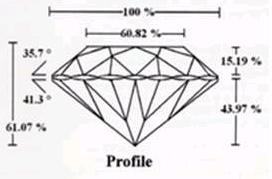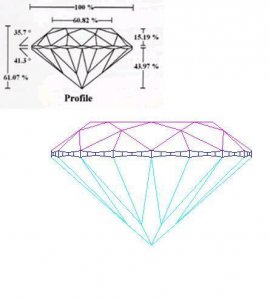- Joined
- Sep 3, 2000
- Messages
- 6,756
Physical measurements are not error free. No measuring device reports perfect accuracy and every device has some small repeatability issue. The measures on 1 carat diamonds from Helium and ImaGem are on par with eachother for accuracy and repeatability. We are both case#1 in the four possible scenarios. Repeatability widens if a lense is used to reduce object size on the sensor. Accuracy may remain quite good or change a bit downward. If one does not need to change lens magnification because the camera sensor is large enough, then a larger object is measured with the same accuracy and repeatability provided the lens is designed correctly.
What we do with physical measurements is a key issue. Helium makes a model from them. ImaGem does not make a model.
Both of us perport to provide information on Light Behavior related to human perception and digital measurement. I think the argument is clear that a direct measurement of Light Behavior on a physical diamond eliminates physical measurement repeatability errors put into a model. The model may prove very useful, but we don't think it is a best case GRADING tool.
Marty, would you prefer GRADING from a model or an actual stone?
Both companies may have some error in the way they either light the diamond for direct measure or send the rays into the stone with digital computation. You don't know the exact light model and I know that bugs you. However, the results correspond with legitimate studies of human perception that have taken place and were tested by outside parties. Its the results that count. Helium may enjoy great results, too. We are not saying it is useless or does not work. We are giving the readers the facts on choices the industry must make. Can someone make a case for using a model for GRADING? I have asked and asked, but this has not been addressed. It requires an answer at some point. I see it as the crucial response.
If I was a cutter or a sightholder looking to develop new cuts or improve cutting of certain details, I might choose to employ a modelling device. There is no better tool for that work to date than Helium. No doubt, Sarin and Ogi are hot on the case to do similar work. There is plenty of talent going around.
The truth is that if we could agree on direct measurement of light then the accurate physical measurement of diamonds may be of less importance than ever before. Unless you want to build a great model, you really don't need super accurate physical measurements for direct Light Behavior measures. The existing tools work pretty good as they have for the past 20 or so years. The reason for high level physical measures is mostly for re-recognition programs that will supplant the now, more or less, unavailable Gemprint system which GCAL now uses in their lab for only diamonds they are grading. GCAL uses a direct measurement system for Light Behavior. Not ImaGem, but not such a long way from it either.
What we do with physical measurements is a key issue. Helium makes a model from them. ImaGem does not make a model.
Both of us perport to provide information on Light Behavior related to human perception and digital measurement. I think the argument is clear that a direct measurement of Light Behavior on a physical diamond eliminates physical measurement repeatability errors put into a model. The model may prove very useful, but we don't think it is a best case GRADING tool.
Marty, would you prefer GRADING from a model or an actual stone?
Both companies may have some error in the way they either light the diamond for direct measure or send the rays into the stone with digital computation. You don't know the exact light model and I know that bugs you. However, the results correspond with legitimate studies of human perception that have taken place and were tested by outside parties. Its the results that count. Helium may enjoy great results, too. We are not saying it is useless or does not work. We are giving the readers the facts on choices the industry must make. Can someone make a case for using a model for GRADING? I have asked and asked, but this has not been addressed. It requires an answer at some point. I see it as the crucial response.
If I was a cutter or a sightholder looking to develop new cuts or improve cutting of certain details, I might choose to employ a modelling device. There is no better tool for that work to date than Helium. No doubt, Sarin and Ogi are hot on the case to do similar work. There is plenty of talent going around.
The truth is that if we could agree on direct measurement of light then the accurate physical measurement of diamonds may be of less importance than ever before. Unless you want to build a great model, you really don't need super accurate physical measurements for direct Light Behavior measures. The existing tools work pretty good as they have for the past 20 or so years. The reason for high level physical measures is mostly for re-recognition programs that will supplant the now, more or less, unavailable Gemprint system which GCAL now uses in their lab for only diamonds they are grading. GCAL uses a direct measurement system for Light Behavior. Not ImaGem, but not such a long way from it either.







300x240.png)